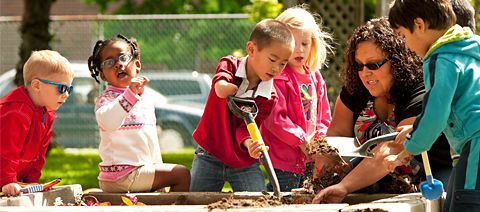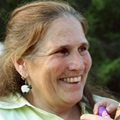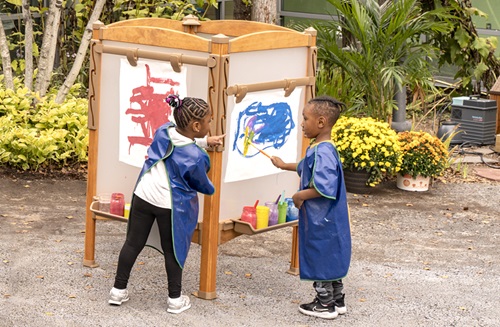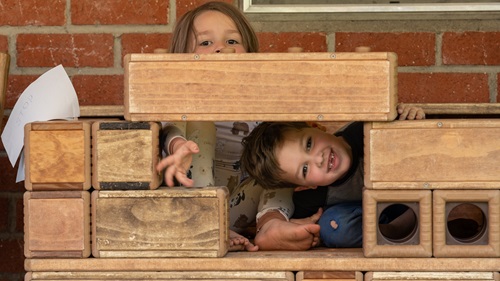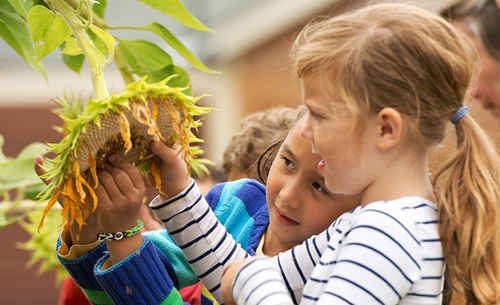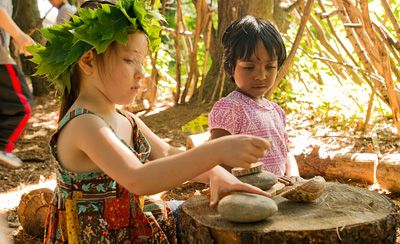Open the Door and Just Go Out
How Outdoor Classrooms naturally support a holistic and integrated curriculum.
|
January 2013
As the first snow was falling and I was walking mid-day, snowflakes were sticking to my eyelashes. This made me hum "a few of my favorite things" from The Sound of Music. Being outdoors and connecting children to nature daily is definitely one of my favorite things. Having a certified outdoor classroom allows teaching to occur naturally and helps each teacher find their favorite things to share and enrich children's lives.
A Natural Curriculum
At Live & Learn Early Learning Center we believe that curriculum is a living, changing medium of learning that grows and transforms with the seasons, children's wonder, nature cycles and the community's needs. We believe that it is vital to children's learning to reflect the world that is immediately around them. This medium is a negotiated curriculum taking the children's wonders and mixing them with the teacher's passion. We take the results of that investigation and implement them in a natural foundation with open ended activities and play. Our nature-based play curriculum and environment expose children daily to the natural world right outside the back door. Children and teachers can delight in hands-on exploration and investigations as a vehicle for learning.
At Live & Learn, for all children ages 6 weeks to 60 years, we believe in the fundamental importance of children's ongoing experience in nature as the foundation for creativity, problem-solving, and critical thinking. Our belief that play is learning creates an atmosphere that ultimately works towards creating a cohesive community. We have taken to heart the writings of Richard Louv's Last Child in the Woods, and made "nature deficit disorder" extinct at Live & Learn. Children express interests and ideas, explore nature and curriculum materials in playful ways. They can reflect on their experiences and form conclusions. Through this process, children develop confidence and independence with encouragement from families, teachers and community members.
Learning in an Outdoor Classroom
Our certified outdoor classroom allows children and teachers to explore and dive into the world around them. Sometimes this involves bringing the outdoors in and then the indoors out. We incorporate both indoor and outdoor classrooms alike for all the areas of development to be reached. They create worm bins, fairy houses, stone walls and animal habitats. Outdoors, children observe plants, animals, trees, the weather and the hundreds of other things that capture their interests. Teachers set the scene daily to encourage the children's minds. We add "loose parts" to areas of the outdoor classroom that may include tree blocks, pumpkins, gourds, flowers, laminated books, and sticks. Teachers observe, participate in, and document children's experiences in order to make thoughtful decisions about how to continue to develop and enhance curriculum.
Learning in an outdoor classroom supports all aspects of an integrated curriculum. It is child-centered and supports an inquiry-based learning model. It naturally encourages wonder. Children can use all of their senses as they observe their environment. The natural materials allow children to sort, classify, count, compare, and examine. The role of the teachers is to guide children to integrate these experiences into cognitive concepts. Teachers should indicate honest interest through their tone of voice and facial expression. Sincerity conveys to children that their responses are important. When you allow time for children to think and respond, you show respect for both the children and their ideas.
In nature we have the opportunity to focus on things in the here and now. Questions that focus on observable events in the children's immediate environment are more likely to elicit a response than questions about objects or events remote in time or distant from the children. Young children focus on the present rather than the past. They need concrete cues to help them recall the past. Model scientific curiosity by asking questions of yourself and the children; for example, I wonder what ants eat? What do you think they eat? Ideally, questions enhance the child's experience, not detract from it.
A Conduit of Risk-taking
I strongly believe that children gain and grow through risk-taking and exploration in the natural world. We have set up the outdoor classrooms to include ways to developmentally risk-take appropriately. There are real tools to dig with in the digging area and large sticks and planks to move and build with in the natural building area. We have set up ropes to balance and climb on, as well as rope swings. Our climbing areas are created from large branches from trees. Our preschoolers and kindergarteners can explore a stream by walking in it and exploring with sticks. Our environment is a 25-acre farm with animals that lends itself to daily exploration.
The essential element to all of this requires that we also have the families on board with our approach to risk-taking. Part of our family orientation includes visiting and playing in the outdoor classrooms. The families are the clients and must be comfortable with their children coming home dirty, sometimes with a skinned knee or scrape, but full of new discoveries and adventures. As a learning community we engage in conversations about thoughts and fears that we all own as adults and how we can give children new and acceptable risk-taking opportunities to build fundamental skills.
There are two key ingredients to risk-taking with children; one is the adults and the other is time. We as the adults in early childhood education must model with enthusiasm, both the permission and support, to risk-take. We must slow down to allow time to dream, imagine, touch, feel, and construct. Children, through acceptable risk, build upon their own ideas, feel empowered physically and emotionally and develop a sense of place or belonging in the environment. I do not want to be responsible for raising a generation of children who have been bubble wrapped. What will happen when there is not caution tape or six warnings before the child reaches the edge? Healthy risk-taking prepares us to be observant and make good decisions.
Taking to heart Rachel Carson's The Sense of Wonder, the teachers of Live & Learn journey daily with their children to enjoy and explore the pleasures of walking in a puddle or stream, digging for salamanders, and learning to appreciate what nature has to teach, and why all of this matters. The enjoyment of childhood and taking time to be a kid is embodied here.

